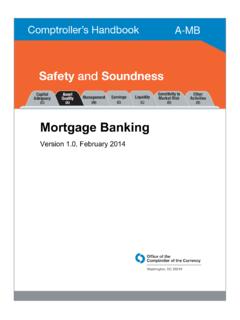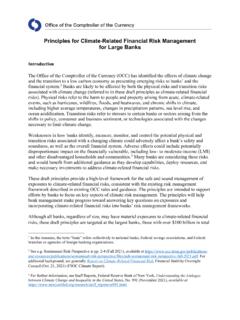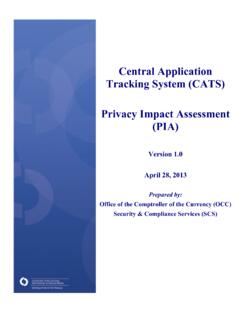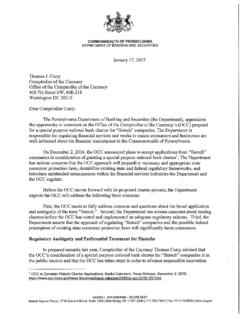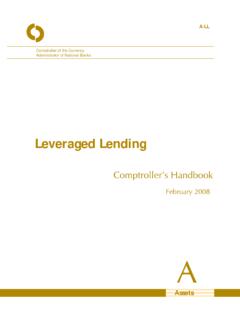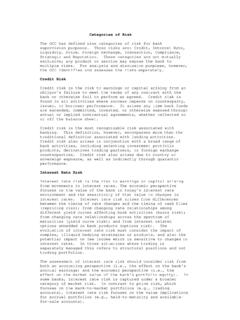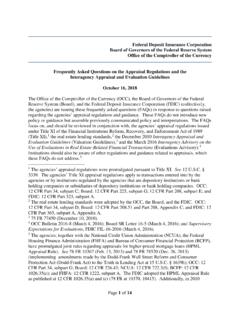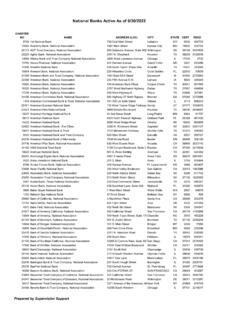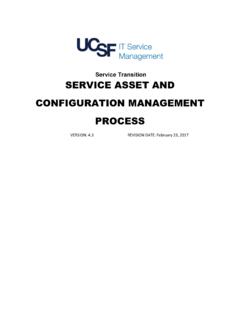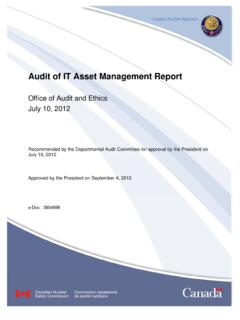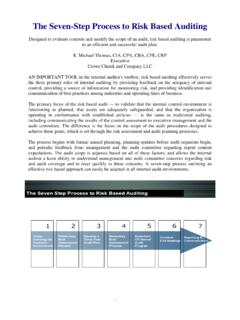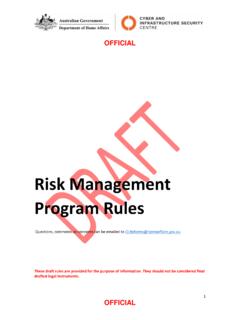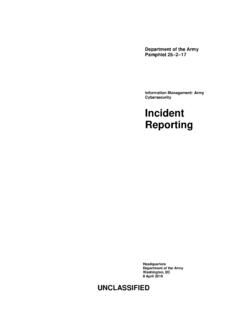Transcription of Loan Portfolio Management - Office of the Comptroller of ...
1 AssetsLoan Portfolio ManagementComptroller s HandbookApril 1998A-LPMC omptroller of the CurrencyAdministrator of National BanksAUpdated June 26, 2017, for Nonaccrual Status loan Portfolio Management i Comptroller s Handbook loan Portfolio Management Table of Contents Overview .. 1 Risks Associated with Lending .. 3 Credit Culture and Risk Profile .. 11 loan Portfolio Objectives .. 13 Strategic Planning for the loan Portfolio .. 13 Financial Goals .. 14 Risk Tolerance .. 15 Portfolio Risk and Reward .. 15 The loan Policy .. 17 loan Policy Topics .. 19 loan Approval process .. 20 Portfolio Management .. 22 Oversight .. 22 Risk Identification .. 22 Nonaccrual Status .. 24 Exceptions to Policy, Procedures, and Underwriting Guidelines .. 25 Documentation Exceptions .. 25 Policy and Underwriting 26 Aggregate Exception Tracking and Reporting.
2 27 Portfolio Segmentation and Risk Diversification .. 28 Identifying Concentrations of Risk .. 28 Evaluating and Managing Concentrations of Risk .. 30 Concentration Management Techniques .. 31 Stress Testing .. 32 Allowance for loan and Lease Losses .. 33 Credit Management Information Systems .. 34 Collections and Work-out .. 35 Lending Control Functions .. 37 Independence .. 37 Credit Policy Administration .. 38 loan Review .. 38 Audit .. 39 Administrative and Documentation Controls .. 39 loan Portfolio Management ii Comptroller s Handbook Communication with Senior Management and the Board .. 40 loan Portfolio Management Supervision .. 41 asset Quality Reviews .. 41 Targeted Reviews .. 42 process Reviews .. 42 Administrative and Documentation Reviews .. 43 Compliance 43 Follow-up Evaluations on Management Commitments .. 43 Ongoing Supervision.
3 43 Examination Procedures .. 45 General Procedures .. 45 Quantity of Risk .. 48 Quality of Risk Management .. 54 Conclusion Procedures .. 70 Appendixes .. 72 Topics of loan Policy .. 72 12 CFR 30 Safety and Soundness Standards .. 78 Portfolio Credit Risk Management Processes .. 80 loan Production Offices .. 85 loan Participations .. 87 loan Brokerage and Servicing Activities .. 92 IRS Express Determination Letters .. 93 References .. 97 loan Portfolio Management 1 Comptroller s Handbook loan Portfolio Management Introduction Overview Lending is the principal business activity for most commercial banks. The loan Portfolio is typically the largest asset and the predominate source of revenue. As such, it is one of the greatest sources of risk to a bank s safety and soundness. Whether due to lax credit standards, poor Portfolio risk Management , or weakness in the economy, loan Portfolio problems have historically been the major cause of bank losses and failures.
4 Effective Management of the loan Portfolio and the credit function is fundamental to a bank s safety and soundness. loan Portfolio Management (LPM) is the process by which risks that are inherent in the credit process are managed and controlled. Because review of the LPM process is so important, it is a primary supervisory activity. Assessing LPM involves evaluating the steps bank Management takes to identify and control risk throughout the credit process . The assessment focuses on what Management does to identify issues before they become problems. This booklet, written for the benefit of both examiners and bankers, discusses the elements of an effective LPM process . It emphasizes that the identification and Management of risk among groups of loans may be at least as important as the risk inherent in individual loans. For decades, good loan Portfolio managers have concentrated most of their effort on prudently approving loans and carefully monitoring loan performance.
5 Although these activities continue to be mainstays of loan Portfolio Management , analysis of past credit problems, such as those associated with oil and gas lending, agricultural lending, and commercial real estate lending in the 1980s, has made it clear that Portfolio managers should do more. Traditional practices rely too much on trailing indicators of credit quality such as delinquency, nonaccrual, and risk rating trends. Banks have found that these indicators do not provide sufficient lead time for corrective action when there is a systemic increase in risk. loan Portfolio Management 2 Comptroller s Handbook Effective loan Portfolio Management begins with oversight of the risk in individual loans. Prudent risk selection is vital to maintaining favorable loan quality. Therefore, the historical emphasis on controlling the quality of individual loan approvals and managing the performance of loans continues to be essential.
6 But better technology and information systems have opened the door to better Management methods. A Portfolio manager can now obtain early indications of increasing risk by taking a more comprehensive view of the loan Portfolio . To manage their portfolios, bankers must understand not only the risk posed by each credit but also how the risks of individual loans and portfolios are interrelated. These interrelationships can multiply risk many times beyond what it would be if the risks were not related. Until recently, few banks used modern Portfolio Management concepts to control credit risk. Now, many banks view the loan Portfolio in its segments and as a whole and consider the relationships among Portfolio segments as well as among loans. These practices provide Management with a more complete picture of the bank s credit risk profile and with more tools to analyze and control the risk.
7 In 1997, the OCC s Advisory Letter 97-3 encouraged banks to view risk Management in terms of the entire loan Portfolio . This letter identified nine elements that should be part of a loan Portfolio Management process . These elements complement such other fundamental credit risk Management principles as sound underwriting, comprehensive financial analysis, adequate appraisal techniques and loan documentation practices, and sound internal controls. The nine elements are: Assessment of the credit culture, Portfolio objectives and risk tolerance limits, Management information systems, Portfolio segmentation and risk diversification objectives, Analysis of loans originated by other lenders, Aggregate policy and underwriting exception systems, Stress testing portfolios, Independent and effective control functions, Analysis of Portfolio risk/reward tradeoffs.
8 loan Portfolio Management 3 Comptroller s Handbook Each of these elements is important to effective Portfolio Management . To a greater or lesser degree, each indicates the importance of the interrelationships among loans within the Portfolio . Their focus is not on individual transactions, but on a group of similar transactions and on verifying the integrity of the process . Each practice, by itself, adds a dimension to loan Portfolio Management , but their value is amplified when they are used together; moreover, the absence of any one of these elements will diminish the effectiveness of the others. These elements are described in greater detail in appendix C and throughout the introductory section of this booklet. All banks need to have basic loan Portfolio Management principles in place in some form. However, the need to formalize the various elements discussed in this booklet, and the sophistication of the process , will depend on the size of the bank, the complexity of its Portfolio , and the types of credit risks it has assumed.
9 For example, a community bank may be able to implement these principles in a less formal, less structured manner than a large bank and still have an effective loan Portfolio Management process . But even if the process is less formal, the risks to the loan Portfolio discussed in this booklet should be addressed by all banks. The examiner assigned LPM is responsible for determining whether the bank has an effective loan Portfolio Management process . This includes determining whether the risks associated with the bank s lending activities are accurately identified and appropriately communicated to senior Management and the board of directors, and, when necessary, whether appropriate corrective action is taken. This booklet contains important background information on loan Portfolio Management that examiners should review before conducting an asset quality examination.
10 The risks unique to specific types of loans are addressed in several separate handbook booklets ( , Commercial Real Estate and Construction Lending, Lease Financing, and Credit Card Lending ). Risks Associated with Lending According to the OCC s supervision by risk philosophy, risk is the potential that events, expected or unexpected, may have an adverse impact on the loan Portfolio Management 4 Comptroller s Handbook bank s earnings or capital. The OCC has defined nine categories of risk for bank supervision purposes. These risks, which are defined in other Comptroller s Handbook sections, are credit, interest rate, liquidity, price, foreign exchange, transaction, compliance, strategic, and reputation. Banks with international operations are also subject to country risk and transfer risk. These risks are not mutually exclusive; any product or service may expose the bank to multiple risks.
